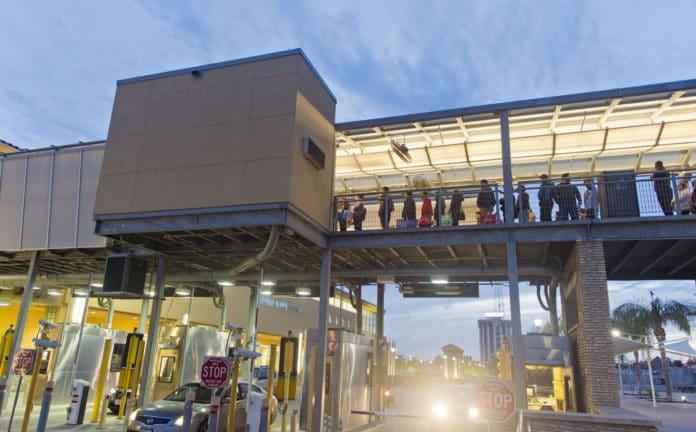The plunge in the peso has throttled the purchasing power of Silvia Guerra’s most important customers: shoppers from south-of-the-border cities like Nuevo Laredo, Monterrey and Saltillo who walk over the Gateway to the Americas International Bridge a few blocks down Convent Street.
“We are dead over here. Business is dead,” Guerra says from her store in Laredo, on the Texas side of the Rio Grande, surrounded by racks of dresses and colorful rolls of fabric as people stroll in and out, without purchasing.
The Mexican currency is a casualty of the global oil-price collapse, and Guerra’s family is testament to the ugly impact of the double whammy in South Texas. She figures she’ll be out of business by May. Her husband lost his job leasing drilling equipment for Weatherford International. Their daughter, an administrator for Baker Hughes in San Antonio, was told her position is at risk after more than 700 firings recently at the oil-services company. Their son, who supervises fracking operations for C&J Energy Services, has seen his paycheck shrink so much he’s looking for side work.
“The news hit like a bomb,” Guerra says, recalling when her husband was laid off 10 months ago after 16 years with Weatherford.
Crude values have plummeted 70 percent since June 2014, crippling Mexican exports and idling rigs in Texas’s Eagle Ford shale formation, which starts just north of Laredo. The peso is down 26 percent against the dollar in the past two years. All Texas border cities are feeling a pinch, with state data showing sales-tax receipts falling as much as 6 percent in the second quarter from a year ago. But merchants in Laredo say business is off 50 percent or more.
“We are talking about millions and millions of dollars per day that Mexicans spend in Texas,” says Roberto Coronado, an economist at the Federal Reserve Bank of Dallas. “The city that depends the most on them is Laredo.”
Some of the pain is a regular part of the ebb and flow in a part of the U.S. that’s reliant on foreigners and a city that, with four international bridges, is the country’s biggest inland port.
“When the Mexican peso gets a cold, Laredo sneezes,” says Les Norton, head of the Downtown Merchants Association, making a play on the Mexican expression about how the health of the U.S. economy reverberates south of the border.
What’s different this time is that Laredo is also taking a hit from the bust in the Eagle Ford, one of the fields behind the surge in U.S. oil output in the past half-decade. The price crash has slashed production, dealing a blow to a state economy that for years has boasted some of the fastest growth rates in the country. The Dallas Fed’s Manufacturing Outlook index, an indicator of how the economy’s doing, showed a 14-consecutive-month contraction in the state in February, while Texas business activity and company indexes fell to their lowest readings since April 2009.
Most of the 115 million people who cross into Texas legally from Mexico every year are on shopping expeditions, and by some estimates are responsible for one of every two retail dollars spent in Laredo. They buy everything from jeans to smart phones to toys, products that have been typically more costly or not widely available at home. Now there’s less incentive to make the trip. A yard of Silvia Guerra’s popular turquoise-colored crepe satin, priced at $8.50, cost Mexicans 127 pesos last year and is 152 pesos today.
Cindy Gallegos, 34, a schoolteacher from Nuevo Laredo, has sticker shock while looking for lace for her wedding dress. After seeing the price tag at Guerra’s — $63 — she walks out. “It’s too expensive,” she says. “When converting to pesos, the price is impossible.”
Many storefronts on Convent Street, downtown’s main commercial drag, and others near the river are boarded up or braced with metal-grids over their windows. Landlords have started leasing space to currency-exchange kiosks hawking dollars at relatively cheap prices. At least 50 of the outfits have sprung up in the past year, according to local merchants.
“They bring in extra income,” says Kush Samtani, who’s struggling to keep his 27-year-old electronics shop open and rents a corner to a kiosk. Almost all his patrons are from Mexico; many re-sell the tablets and bluetooth speakers they buy from him in the Tepito street market in Mexico City. “Now with the peso,” he says, “my customers are not coming anymore.”
Laredo, established in 1755 and home today to 252,309 residents, is among the least affluent cities in Texas. Per capita income is less than $15,500, and about 30 percent of households live below the poverty line. But it bounces back from troubles, says Xochitl Mora, a spokeswoman for the municipal government. “This is not the first time that border businesses have dealt with Mexican peso devaluations, the American recession, or conversely, the oil and gas boom,” she says. “It is, as they say, the nature of the beast.”
Silvia Guerra’s not as confident. Born in the Mexican state of Nuevo Leon 63 years ago, she’s lived in Laredo for 40 years, making dresses from her home and raising three children before finally becomeng a small-business owner four years ago, with two shops downtown. She shuttered the first one last year.
“I started late in life but I said, ‘I don’t care.’ And I did it,” she says. “I’m very sad that I have to close my store.”
_ With assistance from Rita Nazareth.






